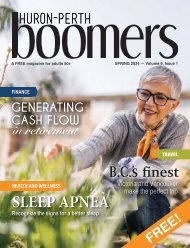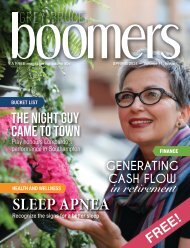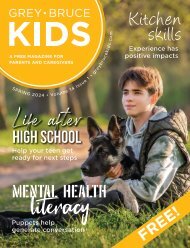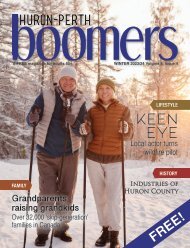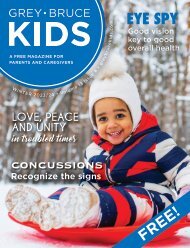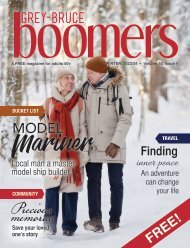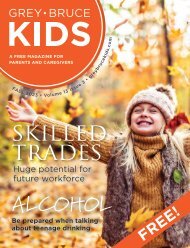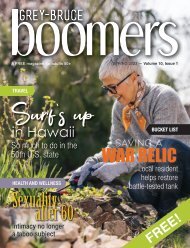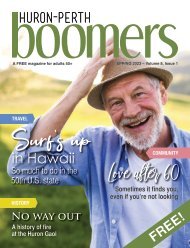Grey-Bruce Boomers Fall 2023
Create successful ePaper yourself
Turn your PDF publications into a flip-book with our unique Google optimized e-Paper software.
A FREE magazine for adults 50+<br />
FALL <strong>2023</strong> — Volume 10, Issue 3<br />
TRAVEL<br />
Mardi Gras!<br />
Earlier is better when<br />
visiting New Orleans<br />
HEALTH<br />
Hearing health<br />
Know the early signs<br />
of hearing loss<br />
BUCKET LIST<br />
No limits<br />
Astrophotographer sees deep into the galaxy<br />
FREE!
ARA Real Estate Brokerage Ltd. Offering<br />
www.arealagent.com<br />
Hilton Lane - Elevated Golf Living<br />
Unit 33 - FAIRVIEW 1830 sq.ft<br />
Walkout with 7th Fairway View<br />
Unit 22 - GREENVIEW 2155 sq.ft.<br />
Views of 3rd Fairway & Green<br />
Unit 30 - ELMWOOD 1633 sq.ft.<br />
Walkout with Treed & Pond View<br />
Unit 27 - PINEDALE 1766 sq.ft.<br />
5th Green & Pond View<br />
Coming Soon to<br />
MEAFORD<br />
Golf View<br />
Bungalows<br />
www.the-fairways.ca<br />
ARA REAL ESTATE CONTACTS:<br />
Ivan Alderdice - Broker of Record<br />
(519) 270-2356 ivan@arealagent.com<br />
Mike Juby - Real Estate Broker<br />
(519) 270-5829 mike@arealagent.com<br />
Unit 1 - ASCOT 1744 sq.ft.<br />
View of 9 & 18th Greens - Loft Elev A shown<br />
Unit 7 - MAYFAIR 2087 sq.ft.<br />
View of 9 & 18th Greens<br />
Maria Casale - Sales Representative<br />
(416) 709-0746 mariacasale@hotmail.com
FROM THE PUBLISHER<br />
Pumpkin Spice is my season. No doubt about it, there’s no time I love<br />
more than fall. Warm September (and hopefully October!) days, cool<br />
mornings and crisp nights – everything smells fresh but also nostalgic at the<br />
same time. Kids are back in school (yeah!), sweaters and leggings come out<br />
and warm comfort meals take over for barbecues. If every day could be the<br />
ideal fall sunny September day, I would be a happy person!<br />
This marks our ninth fall issue of <strong>Grey</strong>-<strong>Bruce</strong> <strong>Boomers</strong>! It’s hard to believe<br />
that when we published our first fall issue, my youngest daughter was four<br />
and is now going into Grade 8, while our oldest was in Grade 2 and now is<br />
behind the wheel! Every once in a while, I like to re-introduce our family to<br />
our readers (picture at right), as <strong>Grey</strong>-<strong>Bruce</strong> <strong>Boomers</strong> is a true, small, familybased<br />
company, not a big corporation. Our family works together – from<br />
writing, editing, selling advertising, and distribution to having the kids do<br />
some heavy lifting by loading magazines into my SUV and running the<br />
house at deadline time.<br />
CONTENTS<br />
The Bucket List • 4<br />
Hearing health • 10<br />
Finding purpose • 16<br />
Mardi Gras! • 20<br />
Alcohol and aging • 26<br />
Recipe • 30<br />
In this issue, the <strong>Grey</strong> <strong>Bruce</strong> Public Health shares the updated guidelines<br />
for drinking alcohol and how the way we process alcohol changes as we<br />
age, while ActivEars Hearing Centres provides insight into hearing health<br />
for the entire family. Doug Archer writes about a fascinating hobby of a<br />
Saugeen Shores resident – astrophotography. Jill Ellis-Worthington takes<br />
us on a trip to New Orleans, with some affordable as well as luxury options<br />
to experience Mardi Gras, and Jo Davis helps us find purpose after age 60.<br />
Thank you to our readers, writers, advertisers<br />
and distributors – I hope you enjoy Pumpkin<br />
Spice season this year as much I do!<br />
Layne, Amy, Jace and<br />
Dwight Irwin.<br />
Amy Irwin, Publisher<br />
<strong>Grey</strong>-<strong>Bruce</strong> <strong>Boomers</strong><br />
FALL <strong>2023</strong><br />
Publisher<br />
Amy Irwin<br />
amy@greybruceboomers.com<br />
Magazine Design<br />
Becky Grebenjak<br />
<strong>Grey</strong>-<strong>Bruce</strong> <strong>Boomers</strong> welcomes<br />
your feedback.<br />
EMAIL<br />
amy@greybruceboomers.com<br />
PHONE 519-524-0101<br />
MAIL<br />
P.O. Box 287, Ripley, ON N0G 2R0<br />
<strong>Grey</strong>-<strong>Bruce</strong> <strong>Boomers</strong> is distributed for free in <strong>Grey</strong> and <strong>Bruce</strong><br />
counties, and is published each March, June, September, and<br />
December. Distribution of this publication does not constitute<br />
endorsement of information, products or services by <strong>Grey</strong>-<strong>Bruce</strong><br />
<strong>Boomers</strong>, its writers or advertisers. Viewpoints of contributors and<br />
advertisers are not necessarily those of the Publisher. <strong>Grey</strong>-<strong>Bruce</strong><br />
<strong>Boomers</strong> reserves the right to edit, reject or comment on all material<br />
and advertising contributed. No portion of <strong>Grey</strong>-<strong>Bruce</strong> <strong>Boomers</strong> may<br />
be reproduced without the written permission of the Publisher.
THE BUCKET LIST<br />
The sky’s<br />
the limit<br />
KEITH MOMBOURQUETTE SPECIALIZES IN ASTROPHOTOGRAPHY<br />
BY DOUG ARCHER<br />
4 • GREYBRUCEBOOMERS.COM
y Doug Archer<br />
Keith Mombourquette has an actual observatory<br />
in his front yard, complete with retractable roof,<br />
a high-powered telescope, star tracking computers,<br />
and cameras that he uses to capture pictures of the<br />
night sky.<br />
THE BUCKET LIST<br />
Keith Mombourquette<br />
in his homemade<br />
observatory.<br />
These night-sky images are not just of the Big Dipper<br />
or the full moon, either. The Saugeen Shores resident<br />
has photographed quasars, nebulas, and even the<br />
Andromeda Galaxy, located some 2.5 million light<br />
years from Earth!<br />
Keith specializes in astrophotography, which<br />
uses cameras and telescopes – and even your own<br />
observatory – to capture pictures of astronomical<br />
objects or celestial events in space. It is a highly<br />
technical, highly complex form of photography and<br />
Keith came to it quite by accident.<br />
He’s always loved photography. Buying his first<br />
camera over 50 years ago, he has been capturing<br />
images ever since. It wasn’t until a night in April<br />
2022 that he turned the camera toward deep space.<br />
“I was down at the Saugeen River, anticipating that<br />
there might be a chance of seeing the Northern<br />
Lights,” Keith explained. “Turned out, I was wrong.<br />
But I did catch a glimpse of what is called the Orion<br />
Nebula, the middle star in the sword of Orion the<br />
Hunter. It was bright and visible that night so I set<br />
up my camera and took some shots, not expecting<br />
much.”<br />
When he got home, however, he was astounded at<br />
how wonderful the images looked.<br />
“The colours of the nebula against the blackness of<br />
the night sky were spectacular – something I’d never<br />
expected to be able to capture in a photograph,” he<br />
said.<br />
The next night he was back at the Saugeen River on<br />
a mission. He spent hours shooting pictures of the<br />
Orion Nebula and, by daybreak, Keith was hooked<br />
on astrophotography.<br />
“I have always been intrigued by the physics of space,<br />
of how things are formed in our galaxy and beyond,<br />
so I think that finally getting into photographing<br />
objects in deep space was a natural progression for<br />
me.”<br />
Of course, taking pictures of deep space is no easy<br />
task.<br />
“To properly capture, say, a distant galaxy requires<br />
long exposures – you need to focus on it and take<br />
images over a six- to eight-hour period,” Keith<br />
explained. “That’s difficult to do, not only because<br />
the galaxy is so far away, but because it is constantly<br />
moving out of alignment with the camera due to the<br />
Earth’s rotation. As one astrophotographer described<br />
it, it’s a bit like trying to photograph a dime that is<br />
floating eight kilometres away and moving at a rate<br />
of 100 km an hour.”<br />
To do that, Keith said, it takes specialized equipment.<br />
FALL <strong>2023</strong> • 5
THE BUCKET LIST<br />
by Doug Archer<br />
For starters, a special astro camera, which is designed to<br />
be more sensitive to the wavelengths of light emitted by<br />
deep-space objects and is mounted on a large telescope.<br />
This is no ordinary telescope, either – it needs to sit atop<br />
a motorized tracking stand that moves in both directions<br />
to counter the rotation of the Earth.<br />
Star Cluster<br />
Then there is the sighting camera. This is a second,<br />
smaller camera that is also mounted on the telescope<br />
and hooked up, along with everything else, to a<br />
controlling computer. Working like a spotter, the sighting<br />
camera relays the position of the celestial object being<br />
photographed to the motorized tracking stand via the<br />
computer. It will send 50 to 100 micro-corrections every<br />
minute to adjust for the movement of our spinning<br />
planet. The tracking stand, in turn, adjusts the position<br />
of the telescope-mounted astro camera so that the<br />
planet or star-cluster or whatever in the heavens Keith is<br />
photographing that night, remains in sight.<br />
All of this is without even mentioning the light pollution<br />
filters, dew shields, camera timers… the list goes on.<br />
“It’s highly technical,” Keith said, “but being an<br />
engineer by training and trade, I love that aspect of it.”<br />
Andromeda Galaxy<br />
Editing deep space photographs is also highly technical.<br />
Over the course of the six to eight hours that Keith’s<br />
telescope-mounted, computer-controlled, mobile<br />
camera is pointed at a celestial body, it will take in excess<br />
of 200 photographs. Turning these into an acceptable<br />
image is where the real work begins.<br />
Many of the pictures will be discarded, spoiled by flying<br />
objects like airplanes and satellites that have photobombed<br />
the image. Using special software, Keith will<br />
then stack the remaining images on top of one another,<br />
bringing the faint, far-away star or nebula into sharper<br />
focus. Finally, he will do what is called a “stretching” of<br />
the image in order to make it brighter.<br />
Pinwheel Galaxy<br />
“The end result, hopefully, is a photo that I am happy<br />
with and that correctly reflects the structure, detail<br />
6 • GREYBRUCEBOOMERS.COM
y Doug Archer<br />
THE BUCKET LIST<br />
and colour of the object in the sky that I was<br />
photographing.”<br />
All of Keith’s space photographs are carefully<br />
scheduled. As he explained it, the bodies in the night<br />
sky change constantly, depending on the time of year<br />
and even the time of night. It takes careful research,<br />
using software programs that provide details on<br />
what will appear in the sky and when, to capture the<br />
images he wants. He then plugs everything into a<br />
spreadsheet that lays out his timetable of night-sky<br />
photo shoots for the next 18 months.<br />
“I even plan what filters I’ll use on my camera and<br />
how long I’ll shoot for,” he laughed. “When you’re<br />
trying to capture photos of objects light years away,<br />
you leave nothing to chance.”<br />
That attention to details has paid off. Keith’s<br />
photographs are, well, out of this world. He shares<br />
them with family and friends on Facebook, but<br />
recently his church asked if they could incorporate<br />
his images into a children’s camp they were hosting<br />
on astronomy and outer space. The pictures were a<br />
hit, taking the kids to the far reaches of our galaxy<br />
and beyond without ever having to leave the ground.<br />
Now Keith is preparing for an astrophotography<br />
contest. His photos will go up against those of other<br />
deep space photographers in what is called Starfest,<br />
Canada’s largest annual amateur astronomy<br />
conference.<br />
Keith is not alone in his love of deep-space<br />
photography. There is a huge community of<br />
astrophotographers around the world, and right<br />
here in <strong>Grey</strong> and <strong>Bruce</strong> counties. He belongs to the<br />
Bluewater Astronomical Society, a local group that<br />
operates the E.S. Fox Observatory located at the<br />
Retirement<br />
Living<br />
at its best!<br />
Retirement Living can be<br />
active, fun & fulfilling!<br />
We know because we<br />
help make it a reality<br />
everyday.<br />
Great Meals<br />
Fun & Engaging Activities<br />
Wellness Programs<br />
Entertainment & Social<br />
Events<br />
Independent &<br />
Supportive Care<br />
Variety of Floorplans<br />
551 Mary Street, Port Elgin, ON, NOH 2C2<br />
T: 519.389.5457 ext.105<br />
sales@elginlodge.ca<br />
FALL <strong>2023</strong> • 7
THE BUCKET LIST<br />
by Doug Archer<br />
Bluewater Outdoor Education Centre near Oliphant.<br />
“They have helped me tremendously,” Keith said. “It is<br />
a wonderful group of astronomers and photographers<br />
who are always willing to provide advice and ideas. And<br />
the bonus is, we get to use the E.S. Fox Observatory<br />
and its telescope to capture spectacular deep-space<br />
pictures.”<br />
His time spent at the observatory also got Keith thinking<br />
about building his own.<br />
Thors Helmet<br />
Rosette Nebula<br />
“With astrophotography, your equipment is outside<br />
most of the night, exposed to damaging dew and rain<br />
and wind,” Keith said. “Plus, there is always the issue<br />
of extraneous light from such things as streetlamps and<br />
houses interfering with the photos. I started erecting<br />
scaffolding draped with plastic tarps to block out the<br />
bad light and to protect against the elements, but that<br />
was only temporary. What I needed was a permanent<br />
solution.”<br />
So, this past January, Keith started designing his own<br />
observatory. It has a roll-off roof, a permanent tracking<br />
mount for his telescope, a backup power supply and no<br />
windows, to minimize the extraneous light. He hired a<br />
contractor to dig the foundation but did everything else<br />
himself.<br />
“I had to be a Jack-of-all-trades,” he smiled. “And some<br />
of it was very tricky. Like how to get that rolling roof<br />
not only to open but to not become airborne in a <strong>Bruce</strong><br />
County windstorm.”<br />
With the help of some sophisticated design work, extrastrength<br />
steel, and the motor out of a treadmill, Keith<br />
found success. Now, at the touch of a button, the roof<br />
rolls off the observatory onto a support frame or gantry,<br />
providing a perfect, protected view of the night sky.<br />
Orion Nebula<br />
The positive impact of the observatory has been<br />
even better than Keith expected. By eliminating light<br />
pollution, it has significantly improved the quality of his<br />
8 • GREYBRUCEBOOMERS.COM
y Doug Archer<br />
THE BUCKET LIST<br />
deep-space images. It has also allowed him to shoot<br />
more photos.<br />
“It used to take me almost an hour to set up the<br />
equipment each night for a photo shoot, and another<br />
hour to take it down. Now the equipment is always<br />
set up in the observatory, ready to go.”<br />
Not only that, but he can operate the equipment<br />
remotely. Keith can retract the observatory roof and<br />
point the astro camera skyward from anywhere in<br />
the world, using only his phone. The only downside<br />
to the observatory has been the light-hearted teasing<br />
Keith gets from his wife Maureen, who refers to it as<br />
his Starship Enterprise.<br />
Still, having his own observatory is only the beginning.<br />
Keith said he is looking into contacting observatories<br />
around the world – in places like Greenwich and<br />
Chile and Antarctica – that will rent time on their<br />
high-powered telescopes to photographers looking<br />
to take images of ‘deepest’ space.<br />
“I am a man of deep faith and do not believe we are<br />
here by accident,” Keith said. “Astrophotography<br />
is letting me truly see and share the majesty of the<br />
created universe.”<br />
Anyone interested in taking up astrophotography<br />
can contact Keith for advice at mombourk@<br />
gmail.com.<br />
Doug Archer is a local writer and speaker who enjoys celebrating<br />
the multi-faceted lives of the 50-plus generation. He is also<br />
the author of three locally set mystery-adventure novels. Learn<br />
more at www.coldcasekids.com or email archer@bmts.com.<br />
INTERNET<br />
DIGITAL TV<br />
HOME PHONE<br />
MOBILE<br />
<strong>Fall</strong> in love with reliable<br />
connection<br />
Escape the Ordinary<br />
Reserve Online | Relax in Nature<br />
SCANDINAVE.COM<br />
519-368-2000<br />
1-866-517-2000<br />
www.brucetelecom.com<br />
FALL <strong>2023</strong> • 9
HEALTH AND WELLNESS<br />
A SOUND<br />
investment<br />
HEAR YOUR WAY TO A VIBRANT FUTURE<br />
BY CHRISTINE FEIGE
y Christine Feige<br />
Physical and mental health often take centre stage,<br />
however it’s equally important not to neglect your<br />
own hearing health. Your hearing connects you to<br />
the world, and preserving good hearing throughout<br />
your life is essential.<br />
How hearing occurs in the brain<br />
Hearing is a complex process that happens in the<br />
brain. Sound waves travel through the ear, and<br />
the brain processes them for comprehension. It’s<br />
important to note that hearing loss, whether caused<br />
by injury, illness, excessive sound exposure, or aging,<br />
can impact brain health, leading to an increased risk<br />
of cognitive decline. Additionally, it affects physical<br />
health by increasing the risk of falls and mental<br />
health by increasing the risk of depression and social<br />
isolation. Understanding the causes of hearing loss is<br />
essential to address the issue effectively.<br />
Clearing the pathway to the brain<br />
Cerumen impaction, or the build-up of earwax, can<br />
have significant effects on optimal hearing health.<br />
When earwax accumulates and blocks the ear canal,<br />
it can lead to symptoms such as decreased hearing<br />
sensitivity, muffled sounds, or even temporary hearing<br />
loss. This impaction not only hinders our ability to<br />
hear clearly but also increases the risk of developing<br />
other complications, such as ear infections or tinnitus.<br />
To ensure optimal hearing health, it’s crucial to<br />
address cerumen impaction promptly. Regular<br />
cleaning and maintenance of the ears by a hearing<br />
health care professional can help to maintain a clear<br />
pathway for sound to reach the inner ear. By taking<br />
proactive steps to manage cerumen impaction, you<br />
can safeguard your hearing abilities and promote<br />
overall optimal hearing health.<br />
Identify hearing loss<br />
Hearing loss can impact individuals of all ages, from<br />
HEALTH AND WELLNESS<br />
infants to older adults. It’s important to recognize the<br />
signs of hearing loss to ensure timely intervention<br />
and support. Detecting hearing loss in children can<br />
be challenging, as they may struggle to communicate<br />
their difficulties. However, there are signs to watch<br />
for, including:<br />
• Delayed language development.<br />
• Difficulty following directions.<br />
• Poor academic performance.<br />
• Inattentiveness or lack of response to sounds.<br />
• High volume when watching TV or listening<br />
to music.<br />
The signs and symptoms of hearing loss can vary<br />
among young adults and adults. Common indicators<br />
include:<br />
• Difficulty hearing conversations, especially in<br />
noisy environments.<br />
• Increasing volume on the TV or radio.<br />
• Frequent requests for repetition.<br />
• Ringing or buzzing in the ears (tinnitus).<br />
• Difficulty hearing high-pitched sounds.<br />
• Avoidance of social situations or withdrawal<br />
from conversations.<br />
Impact on daily life<br />
Hearing loss can significantly impact individuals<br />
of all ages. Untreated hearing loss in children<br />
can lead to difficulty understanding instructions,<br />
communicating with peers, and feelings of isolation.<br />
In teens and young adults, hearing loss can affect<br />
academic and social lives. For adults and older adults,<br />
it can affect communication with family and friends,<br />
job performance, and overall quality of life.<br />
Regardless of age, hearing loss may lead to social<br />
isolation, depression, and cognitive decline.<br />
Prevent hearing loss<br />
Preventing hearing loss is a collective effort that<br />
involves all family members. By being proactive and<br />
FALL <strong>2023</strong> • 11
HEALTH AND WELLNESS<br />
by Christine Feige<br />
taking preventative measures, individuals within the<br />
family can significantly minimize the risk of hearing<br />
loss and preserve their hearing abilities throughout<br />
their lives. Below are key strategies to help prevent<br />
hearing loss at different stages of life.<br />
Children<br />
• Limit exposure to loud noises, such as music<br />
players or fireworks, and provide hearing<br />
protection in noisy environments.<br />
• Encourage safe listening habits, like keeping<br />
the volume at a moderate level when using<br />
headphones or earbuds. Ask about custom<br />
hearing protection plugs.<br />
• Teach children about the importance of taking<br />
breaks from noisy activities to give their ears a<br />
rest.<br />
• Stay vigilant about the noise levels in their<br />
environment, ensuring they are exposed to safe<br />
and comfortable sound levels.<br />
Teens and young adults<br />
• Educate them about the potential risks of<br />
prolonged exposure to loud music at concerts,<br />
clubs, or through personal audio devices.<br />
• Encourage the use of hearing protection, such<br />
as earplugs or noise-cancelling headphones, in<br />
noisy environments. Custom hearing protection<br />
plugs can be made by a hearing health care<br />
provider.<br />
• Encourage regular hearing check-ups and<br />
screenings to monitor hearing health or address<br />
any potential hearing issues.<br />
Adults and older adults<br />
• Protect ears from excessive noise by using<br />
earplugs or earmuffs in loud environments, such<br />
as concerts or construction sites. Custom hearing<br />
protection plugs can be made by a hearing health<br />
care provider.<br />
• Be aware of medication side effects that may<br />
12 • GREYBRUCEBOOMERS.COM
y Christine Feige<br />
HEALTH AND WELLNESS<br />
impact hearing and consult with health care<br />
professionals about potential risks.<br />
• Stay updated with regular hearing assessments to<br />
monitor any changes and take necessary steps to<br />
address hearing loss promptly.<br />
Safeguarding your family’s hearing<br />
Collaboratively, a family unit can play a crucial<br />
role in preventing hearing loss. First and foremost,<br />
creating an environment with reduced background<br />
noise during conversations and family activities is<br />
essential to ensure that everyone can communicate<br />
effectively without straining their ears. This creates<br />
a more conducive environment for maintaining<br />
healthy hearing.<br />
Encouraging healthy lifestyle choices is another<br />
important aspect of hearing loss prevention. A<br />
balanced diet rich in nutrients, regular exercise,<br />
and managing chronic conditions that may impact<br />
hearing, such as diabetes or high blood pressure, can<br />
contribute to overall hearing health. By prioritizing<br />
these healthy habits as a family, individuals can<br />
reduce the risk factors associated with hearing loss<br />
and support optimal hearing abilities.<br />
Open communication about hearing health<br />
and the importance of preventative measures is<br />
crucial within the family. By fostering a dialogue<br />
about hearing health, family members can raise<br />
awareness, share knowledge, and encourage each<br />
other to take proactive steps towards prevention.<br />
Understanding the impact of hearing loss and the<br />
value of prevention, families can support each other<br />
in maintaining healthy hearing habits.<br />
By working together as a family unit, everyone can<br />
contribute to creating a hearing-friendly environment<br />
to ensure long-lasting hearing health for each family<br />
member.<br />
Importance of hearing evaluations<br />
If you or a family member experiences any signs or<br />
symptoms of hearing loss, it’s crucial to seek a hearing<br />
evaluation promptly. During the appointment, a<br />
hearing health care professional will conduct tests<br />
to determine the degree and type of hearing loss<br />
and recommend appropriate treatment options.<br />
Early identification of hearing loss enhances the<br />
effectiveness of treatment.<br />
Understanding the causes<br />
Hearing loss can result from various scenarios,<br />
including natural aging and exposure to loud noises.<br />
The most common causes include aging, noise<br />
exposure, head trauma, viruses or diseases, genetics,<br />
and ototoxicity (damage from certain medications).<br />
This could be you…<br />
Experience the<br />
Freedom to Discover<br />
‘Travel Light with Prolite’<br />
1150 Wallace Ave. N., (Hwy 23) Listowel, ON<br />
1 (888) 453-9105 | www.LonghaulTrailerSales.com<br />
FALL <strong>2023</strong> • 13
HEALTH AND WELLNESS<br />
by Christine Feige<br />
Supporting family members<br />
Supporting loved ones with hearing loss requires<br />
patience and understanding, as communication can<br />
be challenging. Remember these tips:<br />
• Speak clearly and at a moderate pace.<br />
• Face the person directly to allow lip-reading.<br />
• Show patience and understanding.<br />
• Minimize background noise by turning off the<br />
TV or radio.<br />
Additionally, there are assistive devices available,<br />
such as hearing aids, cochlear implants, amplified<br />
telephones, and closed captioning on TVs and movies.<br />
Encourage your loved ones to seek a hearing health<br />
care professional and get an assessment to explore<br />
these options to find what works best for them.<br />
Empowering youth<br />
When discussing hearing loss with children and<br />
young adults, frame the conversation positively<br />
and proactively. Emphasize the importance of<br />
taking care of hearing health and encourage<br />
regular hearing screenings as part of a normal<br />
routine. Discuss the risks and consequences of<br />
untreated hearing loss and highlight the benefits of<br />
maintaining good hearing health.<br />
Hearing health professionals<br />
There are several types of hearing health care<br />
professionals who play important roles in addressing<br />
hearing-related concerns.<br />
Ear, Nose and Throat Specialist (ENT):<br />
Otolaryngologists are medical doctors who specialize<br />
in diagnosing and treating conditions related to the<br />
ears, nose, and throat. They handle a wide range of<br />
ear-related disorders, including complex hearing issues,<br />
and may perform surgical procedures if necessary.<br />
Audiologist: Audiologists are highly trained<br />
professionals who specialize in evaluating and treating<br />
hearing and balance disorders. They are trained to<br />
conduct thorough evaluations, provide diagnostic<br />
services, recommend appropriate treatment options,<br />
and offer rehabilitative services such as hearing aid<br />
fittings and auditory therapy.<br />
Hearing Instrument Specialist: These are<br />
trained professionals who specialize in assessing and<br />
evaluating your hearing levels. They also listen to<br />
your lifestyle needs to help provide the best selection,<br />
fitting, and care for your hearing aids. They play<br />
a crucial role in helping individuals improve their<br />
hearing and quality of life by offering personalized<br />
solutions tailored to their unique hearing<br />
requirements. Hearing Instrument Specialists work<br />
closely with your family doctor or nurse practitioner<br />
to assist you with your hearing health.<br />
Each of these professionals plays a crucial role<br />
in addressing hearing health and contribute to<br />
improving individuals’ hearing abilities and overall<br />
quality of life.<br />
Affected by hearing loss?<br />
Hearing health is a crucial aspect of overall wellbeing.<br />
By staying informed and taking proactive<br />
steps to support your own hearing journey and that<br />
of your loved ones, you can ensure a brighter and<br />
more fulfilling future.<br />
If you have any concerns about hearing health, we<br />
encourage you to book a hearing evaluation with<br />
a hearing health care professional so you can rediscover<br />
the joy of hearing!<br />
Eye-opening stats on hearing loss<br />
Source: World Health Organization<br />
• One-in-six adults 18 and older experiences<br />
hearing loss.<br />
• More than 1.5 billion people worldwide – nearly<br />
20 per cent of the global population – live with<br />
hearing loss.<br />
• By 2050, nearly 2.5 billion people are projected<br />
14 • GREYBRUCEBOOMERS.COM
y Christine Feige<br />
HEALTH AND WELLNESS<br />
to have some degree of hearing loss and at least 700 million<br />
– or one-in-10 people – will have disabling hearing loss<br />
and will require hearing rehabilitation.<br />
• One-in-three individuals over age 65 – 165 million people<br />
worldwide – live with hearing loss.<br />
• Over one billion young adults are at risk of permanent,<br />
avoidable hearing loss due to unsafe listening<br />
practices.<br />
Christine Feige is a Hearing Instrument Specialist and Founder<br />
and President of ActivEars Hearing Centres. Since entering the<br />
hearing industry in 1993, Christine has had the privilege of providing<br />
comprehensive hearing health care to patients throughout Ontario.<br />
ActivEars Hearing Centres are located in Sarnia, Owen Sound,<br />
Hanover, and Durham. Visit www.activears.com. If you or your<br />
loved ones have any questions, please ask any of the knowledgeable<br />
staff at an ActivEars Hearing Centre.<br />
Learn how we make clean energy and medical<br />
isotopes at the <strong>Bruce</strong> Power Visitors’ Centre.<br />
Wonder.<br />
Explore.<br />
Discover.<br />
www.brucepower.com/visit<br />
3394 BRUCE ROAD 20, NORTH OF TIVERTON, WEST OF HIGHWAY 21. T: (519) 361-7777<br />
FALL <strong>2023</strong> • 15
OPINION<br />
Returning<br />
to yourself<br />
Finding purpose and meaning<br />
after age 60 BY JO DAVIS
y Jo Davis<br />
Who knew we’d be talking about finding purpose<br />
and meaning after age 60? Hasn’t the time<br />
for that passed? Our younger lives were filled with<br />
busy-ness – careers, caring for children and elders<br />
and community service – so much purposeful living!<br />
Wasn’t this supposed to be the time to slow down<br />
from all that? It might be… but what if it’s not?<br />
What if we are feeling a little lost or stuck? This can<br />
be a normal response to this era of not being in our<br />
well-worn roles. While it might be time to take things<br />
a bit slower, there is no reason why this time is not<br />
equally as precious for living a life of meaning and<br />
purpose – and even transformation – to something<br />
we never imagined.<br />
One thing I am finding beautiful and meaningful<br />
about this time is spaciousness. If we are fortunate<br />
and privileged, we have space and time to slowly<br />
marinate in what this era can offer. I have often<br />
referred to this time as a “Second Spring,” a time of<br />
reinvention, growth and rebirth, and also a returning.<br />
The following quote from writer Emily McDowell<br />
always strikes me as a profound way of imagining<br />
possibility. “Finding yourself ’” is not really how it<br />
works,” McDowell said. “You aren’t a $10 bill in last<br />
winter’s coat pocket. You are also not lost. Your true<br />
self is right there, buried under cultural conditioning,<br />
other people’s opinions and inaccurate conclusions<br />
you drew as a kid that became your beliefs about<br />
who you are. ‘Finding yourself ’ is actually returning<br />
to yourself. An unlearning, an excavation, a<br />
remembering of who you were before the world got<br />
its hands on you.”<br />
OPINION<br />
So, if in fact you want to engage in some<br />
“marination,” some excavation, and returning to a<br />
self before the world got its hand on you, there are<br />
some great places to start. Most importantly, start a<br />
process to make your values concrete.<br />
Values are our inner compass. They help us<br />
determine our path according to what is important<br />
to us, help us make decisions and live our best life.<br />
We are not often asked to consider our values. They<br />
are generally held unconsciously and arrive through<br />
osmosis from our family of origin or through<br />
experiences. If we are unhappy or feeling stuck often<br />
our values are being squashed. Or simply, perhaps,<br />
we are unaware of the possibilities available to us if<br />
using our “true north.” Values are present in every<br />
part of our lives including work, relationships, leisure<br />
activities, community and learning.<br />
I suggest writing down your Top 5 values and<br />
identifying how much you are living them out on a<br />
scale of one to 10. Make sure each value statement<br />
is action-oriented (how you want to be or act) and a<br />
full sentence, not just one or two words. For example,<br />
“I value being a leader in my community (9/10).”<br />
Values can also be aspirational. You could say<br />
something like, “I want to spend time on activities<br />
that support my mental health such as being in<br />
nature (4/10).”<br />
Not living out a deeply held value (like your 4/10)<br />
might be a reason for your stuckness or purposeless<br />
feelings.<br />
Once you have established your values, spend some<br />
time with them. Journal, have conversations with
OPINION<br />
by Jo Davis<br />
partners or friends, and consider the following<br />
reflective questions:<br />
• How did these values find their way into my life?<br />
• Have they changed over time?<br />
• Why are some values being squashed or not lived<br />
out?<br />
• Where am I living my fullest life?<br />
• What is important about this exercise?<br />
• What is at stake?<br />
After reflecting and feeling comfortable (and honest)<br />
about what you have written, it is important to take<br />
stock and determine some action steps to make<br />
needed changes in your life.<br />
For example, using the statement above, “I want<br />
to spend time on activities that support my mental<br />
health such as being in nature (4/10),” might<br />
indicate some action is needed. Brainstorm ideas<br />
of how to get yourself into nature more often. No<br />
wrong answers!<br />
This could be:<br />
• Ask my partner to walk outside after dinner once<br />
per week.<br />
• Go to the trail outside of town on Saturday.<br />
• Explore a new city park.<br />
• Sit under a tree for 30 minutes.<br />
The possibilities are endless. Rinse and repeat this<br />
process of reflection and action for any of your value<br />
statements that are feeling a little “less lived” than<br />
you want.<br />
18 • GREYBRUCEBOOMERS.COM
y Jo Davis<br />
OPINION<br />
Values are only one step towards living a life of more meaning<br />
and purpose. Other areas to consider include developing a<br />
life purpose statement. Learn to rest without guilt or needing<br />
to earn it. Find joy in small moments. Tame your inner critic.<br />
Find your inner wise-elder. Develop mindfulness. Practice<br />
acceptance and return to yourself. The possibilities are<br />
endless.<br />
This is a new era in your life. Take action on what’s important<br />
to you!<br />
Jo Davis is the founder of Jo Davis Coaching and Facilitation, a personal<br />
development coaching practice that serves women who are leaders both in<br />
their lives and careers. Jo lives in downtown Kitchener with her husband<br />
Paul. They have two sons, and they dream of one day spending large<br />
amounts of time gazing at the beautiful waters of Lake Huron.<br />
It’s Time For A<br />
Fresh Approach On<br />
Retirement Living!<br />
www.owensoundgardens.com | 519.371.7037<br />
FALL <strong>2023</strong> • 19
TRAVEL<br />
Mardi Gras!<br />
NEW ORLEANS SURE KNOWS HOW TO THROW A PARTY<br />
BY JILL ELLIS-WORTHINGTON<br />
20 • GREYBRUCEBOOMERS.COM
y Jill Ellis-Worthington<br />
Go early, go often is an advertising catchphrase I<br />
remember from my childhood, and I definitely<br />
have applied it to trips to New Orleans.<br />
The Big Easy is a great getaway at any time of year,<br />
with an over-the-top celebration of St. Patrick’s Day<br />
(Irish immigrants built many of the city’s levies), big<br />
time fun on New Year’s Eve, and the spring brings its<br />
world-famous jazz festival. Yet, nothing beats a visit<br />
to NOLA during Mardi Gras season; and, yes, it is a<br />
season. Mardi Gras starts the first Saturday after the<br />
new year with King Day and the first parades. The<br />
festivities continue through Mardi Gras proper six<br />
weeks later.<br />
Planning your visit to the Crescent City (a nickname<br />
recognizing its location at a bend in the Mississippi<br />
River) earlier during Mardi Gras season can help<br />
to maximize your experience while minimizing<br />
TRAVEL<br />
expenses. Mardi Gras usually runs mid-February<br />
to early-March, making the weather variable, so<br />
being prepared and dressing in layers is helpful.<br />
Accommodation is less expensive and easier to find,<br />
restaurant lines are shorter, and crowds at parades<br />
are a bit better.<br />
Parades<br />
To get an overview of the parade schedule,<br />
Tourism New Orleans has a great website at www.<br />
mardigrasneworleans.com/parades. There are<br />
descriptions of each type of parade, as not all are<br />
what you might expect. There are versions featuring<br />
pets, kids and tiny floats (built in shoe boxes). Some<br />
are tilted toward an adults-only crowd with explicit<br />
content, while others are family friendly. Explanations<br />
of each parade’s Krewes (organizers), themes and<br />
histories are available on the website. While some<br />
SUITES RENTING FAST<br />
move in now<br />
Welcome to Edgewood Suites, a vibrant adult living community<br />
in the heart of Dundalk, where you can experience the comfort<br />
of small town living, yet close to every modern amenity you<br />
may need. Choose from studios, 1 or 2 bedroom suites featuring<br />
private balconies, and a variety of building amenities.<br />
Starting from<br />
$<br />
1,594<br />
All Inclusive<br />
CONTACT US TO BOOK A TOUR!<br />
edgewoodsuites.ca<br />
(226) 274-5008<br />
info@edgewoodsuites.ca<br />
Prices and specifications subject to change without notice. E. & O. E.<br />
FALL <strong>2023</strong> • 21
TRAVEL<br />
by Jill Ellis-Worthington<br />
‘Painted ladies’ in Algiers, just across the<br />
Mississippi River from the French Quarter.<br />
run right through the French Quarter, others transit<br />
adjacent areas or suburbs. If catching beads is big on<br />
your Mardi Gras agenda, knowing times and routes<br />
may help you choose where you want to stay and<br />
determine your schedule of other sightseeing.<br />
Accommodations<br />
The French Quarter (FQ) and its surrounding areas of<br />
Marginy, Frenchman’s Street and the Garden District<br />
are where most visitors concentrate their interest, so<br />
staying in any of these areas can be beneficial. It’s<br />
great to park the car and walk or take the streetcar,<br />
but you’ll pay more for this convenience. Picking a<br />
hotel on the edge of the FQ (like the Holiday Inn<br />
French Quarter-Chateau Lemoyne) can give you<br />
the best of both worlds. If money isn’t a concern,<br />
the stately Monteleone is located at the heart of the<br />
FQ on Royal Street. It has a heated rooftop pool to<br />
stretch those weary muscles at the end of a touring<br />
day, and its famous Carousel Bar is worth a visit,<br />
even if you’re not staying there. You’ll remember this<br />
unique watering hole from scenes in several movies,<br />
including Double Jeopardy, The Last Time and Girls Trip,<br />
among others.<br />
Airbnbs in and surrounding the Quarter can be a<br />
good choice if you like to have breakfast at home<br />
before exploring. Check the map carefully so you<br />
choose one close to a streetcar or bus stop to minimize<br />
taxi and ride share costs.<br />
On our last trip, we spent just $25 US per night by<br />
taking our travel trailer and staying at Bayou Segnette<br />
State Park near Algiers (one the most colourful<br />
districts of NOLA). The $2 ferry ride across the<br />
Mississippi River took us to the foot of Canal Street<br />
and into the Quarter.<br />
Cheap and free<br />
The French Quarter – Just walking around this<br />
vibrant, eclectic, sometimes seedy part of the city<br />
that seethes with history is worth the trip. Places like<br />
Napolean House (see food section), Jackson Square,<br />
the Voodoo Spiritual Temple and the French Market<br />
will enthrall you.<br />
The Garden District – Investing a few bucks in<br />
a walking tour is worth it to learn which was Anne<br />
Rice’s house when she was penning her vampire<br />
series, which homes belong to Nick Cage, John<br />
Goodman or Sandra Bullock, and which was the<br />
Benjamin Button House. This is one of my favourite<br />
parts of New Orleans, with its grand historic homes,<br />
gracious lawns and old-world charm.<br />
Algiers – Take a ferry across the river and visit the<br />
15th Ward if you love the ‘painted ladies’ as much<br />
as I do. Residents have revitalized this area and are<br />
outdoing each other in making the shotgun homes as<br />
colourful as possible. (www.neworleans.com/plan/<br />
transportation/algiers-ferry)<br />
22 • GREYBRUCEBOOMERS.COM
y Jill Ellis-Worthington<br />
TRAVEL<br />
Sazerac House – This offers great, free tours (but<br />
you must reserve at https://tickets.sazerachouse.<br />
com/p/newhome) detailing the history of cocktails.<br />
You will be able to score some free cocktail samples,<br />
as well.<br />
Waterfront walk – A relaxing stroll along the river<br />
will bring you face-to-face with steamboats, rolling<br />
greenery and the New Orleans Holocaust Memorial.<br />
Cemeteries – NOLA is famous for its aboveground<br />
cemeteries. Unfortunately, some – like St.<br />
Louis Cemetery Number, where notorious Voodoo<br />
priestess Marie Laveau is buried – have been closed<br />
to the public due to vandalism, while others are still<br />
open and worth a visit.<br />
Other stuff to do<br />
Hop-on/hop-off tours are a good idea to see what<br />
you want to explore and get the lay of the land. If<br />
you drove or rented a car, there are sites worth seeing<br />
within easy reach. Houmas House is an antebellum<br />
sugar plantation with tours of the home by costumed<br />
interpreters. The size of the live oaks is amazing;<br />
they’ve had hundreds of years of humanity walk<br />
beneath their boughs. Go for the day, the restaurant<br />
provides delicious food and a gracious atmosphere.<br />
A swamp tour is also a must if you’ve never seen an<br />
alligator jump out of the water to get a marshmallow<br />
on a stick – no, really! Floating under the arms of<br />
mangrove trees, we saw gators and feral pigs, both of<br />
which seem to love marshmallows.<br />
A place for foodies<br />
Being on a delta of the Gulf of Mexico, you know<br />
seafood will be a star, and you can’t miss sampling<br />
the Creole and Cajun cuisines. Some of my favourite<br />
Powerful, Proven, Effective Solutions<br />
for your Denture Problems<br />
Are you having trouble<br />
with your dentures?<br />
Lower<br />
suction<br />
dentures<br />
Save and pass on your valued memories<br />
personal stories family history memoirs<br />
How I can help you:<br />
Writing & editing<br />
Interviewing<br />
Voice recording<br />
Family history research<br />
Arlen Wiebe<br />
For more information, visit your-life-stories.ca<br />
3rd Generation<br />
Denturist with over<br />
30 Years Experience<br />
Hanover Clinic<br />
550 10th Street<br />
(519) 364-3223<br />
Digital Dentures<br />
Owen Sound Clinic<br />
1383 16th Street East<br />
(519) 370-0111<br />
Gag Free<br />
Impressions<br />
with Intra<br />
Oral Scanner<br />
arlen.wiebe.writer@gmail.com phone: 226-668-3352<br />
www.feigedenture.ca<br />
FALL <strong>2023</strong> • 23
TRAVEL<br />
places to eat and drink include:<br />
• Chicory coffee and beignets at Café Du Monde.<br />
Iconic, so you just have to go. If the line is long,<br />
slide over to the takeout window and enjoy your<br />
treats across the street in Jackson Square.<br />
• Grilled oysters at either Drago’s or Acme Oyster<br />
House.<br />
• Muffalettas at Napolean House. For us, this<br />
created-in-NOLA sandwich is a must for every<br />
trip. We love it and the ambiance at Napolean<br />
House. An historic residence gifted to the French<br />
Emperor when he was exiled – though he never<br />
lived there – Napolean House has a hidden oasis<br />
of a patio, as well as indoor seating saturated<br />
with history. The muffaletta sandwich starts with<br />
a special round loaf of the most delicious bread,<br />
which is spread with olive relish and stacked with<br />
various Italian cold cuts and cheese. I recommend<br />
ordering a quarter; it’s a lot of food.<br />
• Breakfast at Ruby Slipper. This eatery has several<br />
locations in and around the French Quarter, and<br />
there will probably be a line-up. Get a breakfast<br />
cocktail (I recommend the Mardi Gras Mimosa)<br />
and relax because it will be worth it. Consider<br />
splitting an order of stuffed French toast or one<br />
of their famous bennies; they are big servings.<br />
• Mudbugs at… well, everywhere. Called crawfish<br />
along most parts of the Gulf Coast, their season<br />
usually starts at the beginning of February.<br />
Get a local to show you how to eat these spicy<br />
freshwater crustaceans. They are so addictive we<br />
call them crawfish crack.<br />
• Cocktails at the Bourbon O’ Bar. A Ramos Gin<br />
Fizz, a Sazerac or a Pimm’s Cup are best enjoyed<br />
at one of the only quiet spots on Bourbon Street.<br />
Hurricanes at Pat O’Brien’s (get a souvenir glass)<br />
are a must for NOLA first timers.<br />
• Classics that serve local inventions and southern<br />
cuisine, include Brennans (originated Bananas<br />
Foster), Antoine’s (the oldest restaurant in NOLA<br />
originated Oysters Rockefeller), and Court<br />
of Two Sisters (live jazz brunch in the lovely<br />
courtyard).<br />
24 • GREYBRUCEBOOMERS.COM
y Jill Ellis-Worthington<br />
A wild alligator jumps<br />
for marshmallows<br />
offered by the tour guide<br />
during a swap tour.<br />
Birthplace of jazz<br />
Bourbon Street was famous for its jazz clubs, but<br />
it’s mostly been given over to alcohol-fueled revelry.<br />
Buskers show off and there’s electricity in its bawdy<br />
nature, but for a taste of local musicianship visit<br />
Frenchman’s Street. You can have a drink and plate<br />
of food while listening to band after band churn<br />
out all musical genres. There’s also a night market<br />
worth checking out.<br />
Safety<br />
NOLA has a reputation as a rough place, going<br />
back to its origins as a major port with pirates<br />
and warships going in and out. The fact that the<br />
North American version of the mafia originated<br />
there didn’t enhance its safety rating. But, like most<br />
places, if you’re smart, practice good situational<br />
awareness, keep to the main areas and don’t<br />
participate in illegal activities, you’ll be fine.<br />
Proud supporters<br />
of agriculture in<br />
Midwestern Ontario,<br />
Miller Insurance<br />
specializes in<br />
agriculture business<br />
and farm policies.<br />
Contact one of our<br />
offices today.<br />
A writer, public relations professional, traveller and football<br />
fan, Jill Ellis-Worthington celebrates life every day. You can<br />
follow her blog at www.writeoncommunicationservices.com.<br />
FALL <strong>2023</strong> • 25
HEALTH AND WELLNESS<br />
Alcohol<br />
and aging<br />
THE WAY THE BODY PROCESSES ALCOHOL CHANGES<br />
THE OLDER WE GET BY BAILEY RESSLER
y Bailey Ressler<br />
Many people enjoy drinking beer, indulging in<br />
their favourite spirit, or sipping some wine<br />
while celebrating, socializing, or to relax.<br />
But, did you know that as we age, the way our<br />
bodies process alcohol changes? The circumstances<br />
surrounding our drinking may also be changing and<br />
we may experience different effects. It’s important to<br />
consider these changes when making decisions about<br />
our alcohol use and how we can better our health.<br />
The facts about alcohol<br />
Alcohol is the most-used psychoactive among<br />
Canadians. Also known as ethanol or ethyl alcohol,<br />
alcohol is a legal substance that is present at varying<br />
levels in beverages like wine, beer, and spirits.<br />
In Canada, alcohol is the leading risk factor for<br />
HEALTH AND WELLNESS<br />
premature death, disease, and disability. There are<br />
a variety of short- and long-term effects associated<br />
with alcohol consumption. Short-term effects can<br />
include an increased risk of violence, injury, and<br />
alcohol poisoning, while long-term effects may<br />
include alcohol dependence, stroke, disease of the<br />
heart or liver, mental illness, and cancer.<br />
Alcohol is also a depressant. Depressants can slow<br />
the functioning of the central nervous system, which<br />
includes the brain.<br />
Changes to Canada’s alcohol guidance<br />
Guidance on alcohol consumption has evolved over<br />
the years. Early in <strong>2023</strong>, the Canadian Centre of<br />
Substance Use and Addiction released Canada’s<br />
Guidance on Alcohol and Health, replacing the Low-<br />
Risk Alcohol Drinking Guidelines issued in 2011. The<br />
Custom Hearing Aids, Repair & Maintenance, Custom Ear Plugs and More!<br />
Re-Discover<br />
the Joy of<br />
Hearing! TM<br />
Your first steps to<br />
Better Hearing<br />
Earwax Removal<br />
Hearing Test<br />
Book An Appointment Today!<br />
HANOVER<br />
519.364.4327<br />
OWEN SOUND<br />
519.371.3290<br />
DURHAM<br />
519.369.3277<br />
SARNIA<br />
519.337.2679<br />
activears.com<br />
PREVENTION ASSESSMENT TREATMENT<br />
FALL <strong>2023</strong> • 27
HEALTH AND WELLNESS<br />
by Bailey Ressler<br />
Guidance provides evidence-based information on<br />
alcohol to support individuals in making informed<br />
decisions about their alcohol use and, ultimately,<br />
their health.<br />
A key factor to consider when discussing alcohol<br />
and associated risks involves understanding what<br />
a “standard” drink is. Standard drinks include the<br />
following:<br />
• One beer (341 ml or 12 oz of 5% alcohol).<br />
• One cooler, cider, or ready-to-drink beverage<br />
(341 ml or 12 oz of 5% alcohol).<br />
• Wine (142 ml or 5 oz of 12% alcohol).<br />
• Spirits, such as whiskey, vodka, or gin (43 ml or<br />
1.5 oz of 40% alcohol).<br />
Understanding what a standard drink is and how to<br />
measure one will help you to understand Canada’s<br />
Guidance on Alcohol and Health.<br />
Continuum of risk<br />
The new guidance highlights a continuum of risk<br />
for consuming alcohol and shines a light on the link<br />
between alcohol consumption and an increased risk<br />
for cancer and other negative health outcomes. This<br />
continuum is associated with an average weekly<br />
consumption of standard alcoholic drinks:<br />
• No risk (zero drinks per week) – Associated with<br />
better health and better sleep.<br />
• Low risk (one to two standard drinks per week)<br />
– Individuals are likely to avoid alcohol-related<br />
harms.<br />
• Moderate risk (three to six standard drinks per<br />
week) – The risk of developing several types of<br />
cancer increases.<br />
• Increasingly high risk (seven or more standard<br />
drinks per week) – The risk of heart disease and<br />
stroke increases.<br />
• For each additional standard drink, your risk of<br />
alcohol-related consequences notably increases.<br />
The guidance notes that no matter where you are on<br />
the continuum, for your health, less alcohol is better.<br />
It also states that consuming more than two standard<br />
drinks per occasion is associated with an increased<br />
risk of harm to self and others, including injuries<br />
and violence.<br />
Alcohol and aging<br />
As we age, the body goes through a variety of changes<br />
that can influence the way substances may affect you<br />
and the magnitude of their effects. These changes<br />
can include:<br />
• Your body may break down substances more<br />
slowly, causing them to remain in your body<br />
longer.<br />
• You may have more body fat and less muscle.<br />
• You may have lower water content in your body<br />
than when you were younger.<br />
• Due to changes like these, older adults tend to<br />
have a lower tolerance for substances. This may<br />
mean that you require less of any substance to<br />
get the desired effect. It also means you may be<br />
more likely to encounter negative effects from<br />
alcohol consumption, such as:<br />
o Increased risk for injuries because of<br />
falls due to loss of muscle strength, poor<br />
balance, and coordination.<br />
o New or worsening mental health issues,<br />
including depression, confusion, and<br />
memory loss.<br />
o<br />
Worsening of health issues such as<br />
diabetes, liver damage, blood pressure or<br />
stomach ailments.<br />
• Interactions with medications. Many medications<br />
don’t have the desired effect when taken with<br />
alcohol; this includes more, or less, intense<br />
effects. Some medications should not be taken<br />
with alcohol at all.<br />
• In addition to the physical changes we experience<br />
as we age, many older adults deal with loss in a<br />
multitude of ways. This can include the loss of a<br />
loved one, mobility, a job, independence, and health.<br />
• Due to these life-altering circumstances, some<br />
older adults increase their alcohol consumption<br />
to cope.<br />
28 • GREYBRUCEBOOMERS.COM
y Bailey Ressler<br />
HEALTH AND WELLNESS<br />
Signs of an alcohol problem<br />
Many older adults are able to drink without developing<br />
any problems, but this isn’t the case for some. Older<br />
adults who feel like they are unable to stop drinking<br />
may be alcohol dependent. Individuals who are<br />
alcohol dependent may experience withdrawal if<br />
they were to suddenly stop drinking alcohol.<br />
Signs of alcohol problems can include:<br />
• Problems sleeping.<br />
• Poor coordination, falls, and slurred speech.<br />
• Lack of self care – not bathing, eating, or taking<br />
care of other health issues.<br />
• Alcohol withdrawal symptoms such as tremors, a<br />
racing pulse or irritation.<br />
• Tension between the individual and friends or<br />
family.<br />
• Lack of interest in usual activities.<br />
• Irritability, confusion, or depression.<br />
• Dishonesty in an effort to hide their drinking.<br />
alcohol use has benefits for your health and wellness.<br />
Sources<br />
Canadian Centre on Substance Use and Addiction. Canada’s<br />
Guidance on Alcohol and Health. Jan <strong>2023</strong><br />
Centre for Addiction and Mental Health. Alcohol Use in Older<br />
Adults. N.d.<br />
Public Health Agency of Canada. Using substances as an<br />
older adult. Aug 2 2022<br />
Bailey Ressler is a Health Promoter at <strong>Grey</strong> <strong>Bruce</strong> Public<br />
Health and a member of the organization’s Chronic Disease/<br />
Injury Prevention Team. Bailey joined GBPH in March<br />
2021. In her free time, Bailey enjoys being outdoors, at the<br />
beach, and spending time with friends and family. Learn more<br />
at www.publichealthgreybruce.on.ca.<br />
How to address your drinking<br />
While the most effective method of reducing the harm<br />
associated with your drinking would be to not drink<br />
at all, this isn’t always feasible or preferable for many<br />
people. If you do choose to drink, following Canada’s<br />
Guidance on Alcohol and Health can help you keep your<br />
drinking at a level that is considered low risk.<br />
The guidance contains tips to help you stay on target:<br />
• Drink slowly.<br />
• Drink lots of water.<br />
• For every drink of alcohol you have, ensure you<br />
have a non-alcoholic one.<br />
• Eat before and while you’re drinking.<br />
• Set a limit for yourself and stick to it.<br />
• Enjoy alcohol-free weeks or activities.<br />
Regardless of how much you drink now, it’s important<br />
to remember that there are things you can do to<br />
reduce your risk of alcohol-related harms. Drinking<br />
less is always better and note that any reduction in your<br />
L I V E M U S I C<br />
L O C A L F O O D<br />
F U N & G A M E S<br />
LIVING HISTORY<br />
FREE FOR MEMBERS<br />
& KIDS UNDER 5<br />
F A M I L Y : $ 2 7 . 5 0 + T A X<br />
greyroots.com<br />
FALL <strong>2023</strong> • 29
FOOD & DRINK<br />
Curried apple<br />
and onion soup<br />
Preparation Time: 15 minutes<br />
Cooking Time: 25 minutes<br />
Serves: 4 to 6<br />
INGREDIENTS<br />
3 tbsp butter<br />
2 onions, chopped<br />
1½ tbsp curry powder<br />
4 cups vegetable or chicken broth<br />
2 apples, diced<br />
2 tbsp apricot jam<br />
2 cups 2% milk<br />
1 cup 35% whipping cream<br />
1 tbsp honey<br />
½ tsp salt<br />
1½ tbsp cornstarch<br />
¼ cup cold water<br />
1 tbsp fresh lemon juice<br />
Salt and pepper<br />
¼ cup chives, chopped<br />
Apple, thinly sliced<br />
Instructions<br />
In large pot, melt butter over medium heat. Add onions and cook,<br />
stirring occasionally until onions are soft, about six minutes. Add<br />
curry powder and cook, stirring constantly for one minute. Stir<br />
in broth, apples and jam. Cover and bring to boil. Reduce heat<br />
and simmer, uncovered for 10 minutes.<br />
Transfer soup to blender or food processor, in batches if necessary,<br />
and purée until smooth. Return soup to pot over medium-low<br />
heat. Add milk, cream, honey and salt.<br />
In small bowl, stir cornstarch with cold water until smooth. Stir<br />
into soup and bring to simmer, stirring constantly, until thickened.<br />
Stir in lemon juice. Season to taste with salt and pepper. Serve<br />
garnished with chives and apples.<br />
*Recipe courtesy of Foodland Ontario<br />
30 • GREYBRUCEBOOMERS.COM
Route 1<br />
Route 2<br />
Highway 10<br />
Owen Sound to Dundalk<br />
Highway 10<br />
Dundalk to Orangeville<br />
MON to SUN<br />
MON to FRI<br />
Book Your Ride<br />
BOOK<br />
<strong>Grey</strong>.ca/GTR<br />
Route 3 Highway 26<br />
Owen Sound to Meaford<br />
Route 4 Highway 26<br />
Meaford to Blue Mountain<br />
CALL<br />
Highway 6<br />
1-226-910-1001 Route 5 MON to FRI<br />
Owen Sound to Wiarton<br />
MON to SUN<br />
MON to SUN<br />
FALL <strong>2023</strong> • 31



